
Exploration at Loulo in Mali, where a 12 million oz gold resource has been delineated,
illustrating just how prospective West Africa is.
The Challenges and Potential for West Africa
Despite the high logistics and operating costs involved, mining is booming
in this remote region
By Antonio Ruffini, South Africa-based Editor

By way of illustration, BME’s infrastructure in West Africa by necessity involves mine-dedicated emulsion facilities. “While it is easy to transport the oxidizer, the ammonium nitrate, and maintain it on site, the unavailability of road transport tankers because of the remoteness necessitates having the emulsion facilities on site,” Hennecke said.
The scarcity of shipping is an issue all suppliers to mines and projects in West Africa have to cope with, but it is exacerbated for explosives companies. It affects the transport of ammonium nitrate, which even when not classified as an explosive is classed as a hazardous material. It sometimes takes three to four months to get the material to destination and this affects the stockholdings required. Keeping six to eight months of buffer stock on site to ensure the mine keeps on running makes logistics expenses 100% higher than in South Africa.
Yet, in spite of logistical and other challenges, West Africa is booming, according to lists of feasibility stage and further advanced mining projects that various companies compile in-house to track opportunities in Africa. One such list, that of Jacob Matonga, business development manager of Africa focused South African project house K’Enyuka, indicates that West Africa offers the greatest number of new mining projects on the continent outside a southern African region that includes South Africa.
Part of the reason, Hennecke suggests, is that five years ago it was harder to do business in West Africa. “It has improved and a great deal of infrastructural development is under way,” Hennecke said. “We are seeing massive mining in the region, whereas in the past, we saw small scale mining. We have also seen the economic effects including job creation. That has made it easier to do business in the region. In addition, many of the West African countries are very peaceful.”
Hennecke predicts that the market for explosives in Africa, due to the mining sector, will double in the next five years, and almost half of this doubling will be due to activity in West Africa. He identifies bauxite in Guinea, iron ore in Guinea, Senegal and Mauritania and Niger’s uranium deposits as key main areas of activity. This is in addition to West Africa’s world famous gold mining and exploration sector that is extending its reach across many of the region’s countries.
However, for many, West Africa first and foremost means Ghana, the long established anglophone gold mining center, where three of the world’s gold mining majors operate mines: Newmont, Gold Fields and AngloGold Ashanti. For all of these companies, this is a base for growth.

Glenn Baldwin, Gold Fields’ head of international operations, explained that the medium term goal is to grow the company’s West African operations from its current attributable output of 675,000 oz/y of gold. Gold Fields has a 71.1% holding in Tarkwa and Damang. The government of Ghana has a 10% share in these operations, with Canadian company Iamgold owning the remainder.
As part of its target to produce 1 million oz/y in West Africa, Gold Fields is completing the $160-million expansion of its carbon- in-leach (CIL) plant at the Tarkwa mine from 450,000 metric tons (mt) per month to 1 million mt/month. This plant, which is expected to be in full production by the end of 2008, will produce an extra 80,000 oz/y of gold, increasing Tarkwa’s total production from 670,000 oz/y to 750,000 oz/y. This may be even higher during the first years and will maintain at that level for 10 years, out of Tarkwa’s remaining 15-year life of mine. The Tarkwa orebody is well understood, and its remaining reserves stand at 11.2 million oz of gold at a grade of 1.5 g/mt, while the resource at Tarkwa stands at 15.4 million oz at a grade of 1.2 g/mt.
The CIL plant expansion at Tarkwa includes adding a second mill, two additional thickeners, nine additional CIL tanks which are about 23 meters (m) tall to supplement the existing seven, and the addition of a second conveyor to the mills. The operation, which produces some 20 million mt/y of ore and has been processing 5.5 million mt/y in its existing CIL plant with the balance being processed in heap leach plants, will change the ratio of this production. When the expanded CIL plant is in full production some 12 million mt/y of Tarkwa’s projected 22 million mt/y of ore will go through it. The CIL plant will achieve recoveries in the high 90% range, compared to the 60% or so achieved by the heap leach pads, and this will see an immediate gain in ounces of gold produced.

Electricity price increases are another major source of operating cost escalation. To combat the unavailability of electricity due to drought, a few years ago Gold Fields together with three other mining companies, Newmont, AngloGold Ashanti and Golden Star, entered into a deal to build a nominal 80-megawatt (mw) gas-fired power station, where Gold Fields was allocated 20 mw. This power station, which connects to the Ghanaian grid, currently runs on diesel though the original intension was for it to be supplied via a gas pipeline from Nigeria. That is still the plan. However, in the interim the cost of electricity has gone up, from $0.06/kWh in 2007 to $0.10/kWh in 2008, with a further increase under negotiation.
Baldwin also explained that Ghana requires a high level of interaction with government, both at a more senior level and in terms of having a closer relationship. “As we also experienced in South America, the relationship with the government is more symbiotic than in places like Australia and the U.S.,” Baldwin said.
A few years ago it looked likely that Gold Fields would expand its footprint in West Africa beyond Ghana, to Burkina Faso, thanks to the advanced stage Essakane project in joint venture with Canadian junior Orezone. However, Gold Fields opted out of that project. “It’s a good orebody, but it lacks the upside potential that, say, Cerra Corona has,” Baldwin said. “Essakane is a great project, but it is not for us. We would have had less than 60% of the attributable production, but would have been operator and carried all the risk in a project that would have been the major contributor to the GDP of one of the world’s poorest countries.” It would have entailed establishing a new set of relationships and would have taken up a lot of management time.
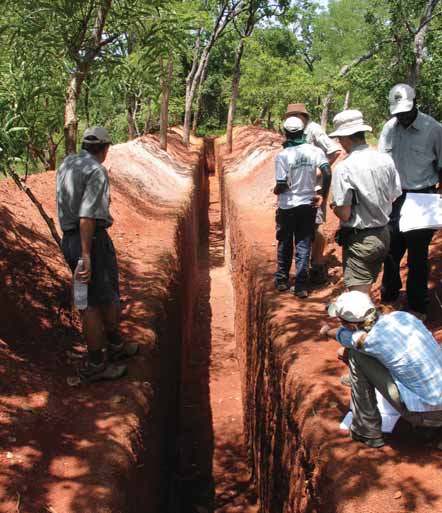
While the bulk of AngloGold Ashanti’s 2007 production (43%) came from South Africa, its operations in West Africa contributed 23%, with Ghana responsible for 10%, Mali 8% and Guinea 5%.
“We face many challenges in terms of operating, not just in West Africa, but in Africa generally,” said Richard Duffy, executive vice president, AngloGold Ashanti. “The key challenges for us, particularly in West Africa, revolve around costs, energy and the changing tax situation. There certainly is potential for AngloGold’s West African operations to improve their contribution to the broader group as a whole. If we get on top of the threat of spiralling costs, particularly around energy, I think we will get the equation right.”
Duffy said the company’s Siguiri gold mine in north-eastern Guinea has considerable upside potential to expand, and the focus there is on investing in scaling up the operation. “Generally Siguiri is going pretty well for us,” Duffy said. “It has improved its production this year and we are confident we will meet the 306,000 oz guideline, or go slightly higher to about 310,000 oz, which will be 10% up on last year.
“The short-term focus for Siguiri is to get an exploration strategy in place that allows us to better understand its potential, and to develop an understanding of the harder sulphide material that sits below the existing softer oxide material,” Duffy said. “We would expect to continue to see resource addition and reserves, and in terms of the mine life of 10 to 12 years, it could be a great deal longer than that. There’s a lot more potential than we have currently brought to the table.”
Siguiri is one of the two West African operations the company is particularly excited about. The other is the world famous Obuasi underground mine it is busy turning around. “At Obuasi in southwestern Ghana the focus is on an intervention that will provide appropriate support to get the mine, currently producing 360,000 oz/y, back to 400,000 oz/y in the first instance, and then through 500,000 oz/y, before we look at the Obuasi Deeps potential which would take us beyond that,” said Duffy. “The first step is to get beyond 400,000 oz next year, and achieving 500,000 oz/y will probably take another year or two.”

In Mali, AngloGold Ashanti has interests in three operations: Morila (40%), Sadiola (38%) and Yatela (40%). “We manage Sadiola and Yatela, and decided to remain as an investor in Morila, having passed operatorship over to Randgold Resources,” Duffy said.
Randgold Resources
Prospers in West Africa
Randgold Resources has prospered in West
Africa, and in particular in francophone
West Africa beyond the comforts of the well
established Ghanaian mining sector. The
company underlies the region’s prospectivity
having to date discovered four world
class gold deposits totalling some 15 to 20
million resource oz.
Morila, now in its twilight years, was the first of these deposits. The second was Loulo, also in Mali, with a 12 million oz gold resource and a 7.4 million oz reserve where underground mining recently commenced— this the first big underground mine in west Africa in 100 years, since Obuasi. The third deposit is the Tongon project in the Cote d’Ivoire where construction work on the 300,000 mt/month mine is due to commence at the end of 2008. The fourth major discovery is the Massawa prospect in Senegal, and Randgold Resources CEO Mark Bristow explained that he has never seen anything as exciting as Massawa outside AngloGold Ashanti’s Obuasi deposit.
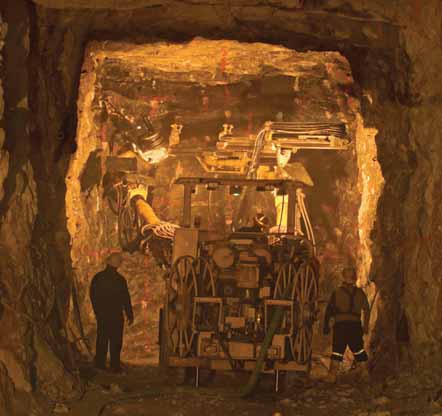
The find is not a coincidence. Bristow pointed out that Randgold Resources has been exploring in Senegal for nine years and this find was a second order anomaly which was only evaluated as part of its second round of exploration.
Bristow explained the strategy behind the success Randgold Resources has achieved. “We started out by asking ourselves where the world class gold deposits are to be found, the plus 2-million-oz deposits.” The answers Randgold Resources came up with were; western and central South America, incorporating Chile and Argentina; the western portion of the U.S., Nevada in particular; the archean geology in Canada; the Kaapvaal craton in South Africa; the archean craton that covers northwestern Tanzania, the Central African Republic and the Democratic Republic of Congo; the Kalgoorlie region of Australia; the Pacific Rim comprising Indonesia and Papua New Guinea; and a geological structure that covers south and central Siberia and northern Mongolia. And then there is the Birimian Shield in West Africa, which covers Burkina Faso, Niger, Ghana, Mali, Guinea and eastern Senegal.
Bristow said the francophone countries of West Africa have no real mining legacy, though data exists from the French geological surveys done during the colonial period. “It remains virgin territory as far as mining potential is concerned,” Bristow said. “Also, in effect, there is no tribalism in francophone West Africa; if one speaks French one can deal with everyone.”
Bristow noted that a lot of the big mining groups have not made it in West Africa outside of Ghana; only now are they returning as emerging markets replace established markets such as Canada, Australia, U.S. and South Africa as mining destinations. “But you can’t manage projects in places like West Africa remotely,” Bristow said. “One has to have relationships on the ground.”
He and senior executives have spent the past nine months doing public participation exercises, going from village to village in the Cote d’Ivoire to discuss the company’s Tongon project. Randgold Resources’ track record also speaks for itself with a $12 million investment in Morila in Mali turning it into a $1 billion project, where the Malian government has made $550 million in taxes.
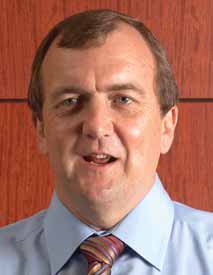
Randgold Resources is expecting attributable production of 400,000 oz this year and as its Loulo underground mine builds up this will extend to more than 600,000 oz by 2011. The 300,000-mt/month Tongon mine in Cote d’Ivoire, the company’s third mine which has a reserve of 3 million oz and a resource of 4 million oz of gold, will add another 200,000 oz/y.
Tongon will be supplied by grid power which is based on hydroelectric and gas fired generation, at about $0.10/kWh, and the mine is also putting in place a back-up 20-mw power station. “We are assisting with the building of the infrastructure that includes a 30-km 90 kva power line extension to the mine,” Bristow said. “One of the keys to getting Tongon into gear is a bridge we have built, the wall of which also creates a temporary water storage dam.” Senet, a South African project company, is the preferred EPCM contractor for the Tongol project and Randgold is acting as its own company representative.
“We know the labor legislation and the landscape better than anyone,” Bristow said. “We worked with the government in settling the interpretation of some of the aspects of the mining convention, such as how the tax incentives work. We did the same in Mali, where legislation had to be changed for us to use the mining rights to raise funding.” He added that it is a misconception that the tax regime in Mali is lenient, as many people assume. The corporate tax is 35% and there is a 6% royalty.
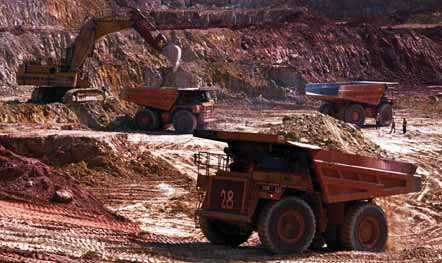
The Mano plan 18 months ago was to mine New Liberty’s open-pit reserves of 550,000 oz at a rate of 70,000 to 75,000 oz/y, giving it a mine life of seven years. “We still plan to mine the mentioned reserves; however a decision on how this will be mined will depend on the results from further drilling targeting deeper zones. This will significantly increase the annual production estimates as well as the life of the mine. New Liberty’s resource alone is likely to push to significantly north of 2 million oz. Pending a mine decision being made on the potential underground operation we believe that at full production an annual target of 150,000 oz to 200,000 oz is achievable for some 15 years or more,” da Siva said.
Mano also illustrates how gold is not the only story in West Africa; whereas in the past large scale infrastructure intensive base metals projects was the stuff of dreams, some of these will now become reality. One such possibility is Mano’s Putu Range iron ore project in Liberia, where Russian steel and natural resources company Severstal, through its wholly-owned Dutch subsidiary, Lybica Holding, signed a subscription and share purchase agreement worth $41.5 million in May this year for a 61.5% stake in the project.
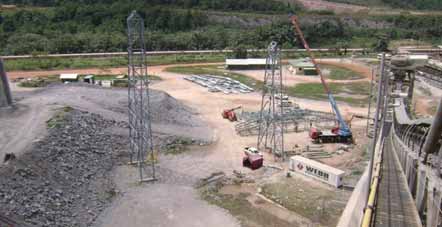
Putu will provide good average grades and substantial volumes. “Following the latest report by SRK, we increased Putu’s resource estimates to 900 million mt,” da Silva said. He explained that Mano is looking at three preliminary scenarios for the submission to the government of Liberia. These involved production levels of 8, 12 and 24 million mt/y.
“All of this is of course subject to the 25-year mining license,” da Silva said. “Furthermore, we envisage that developing the mine at Putu will require significant infrastructural development—we will have to lay down approximately 130 km of rail, build a modern seaport, develop roads and construct a mining camp.”.